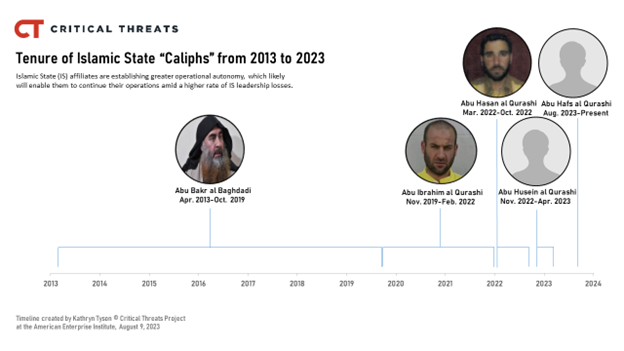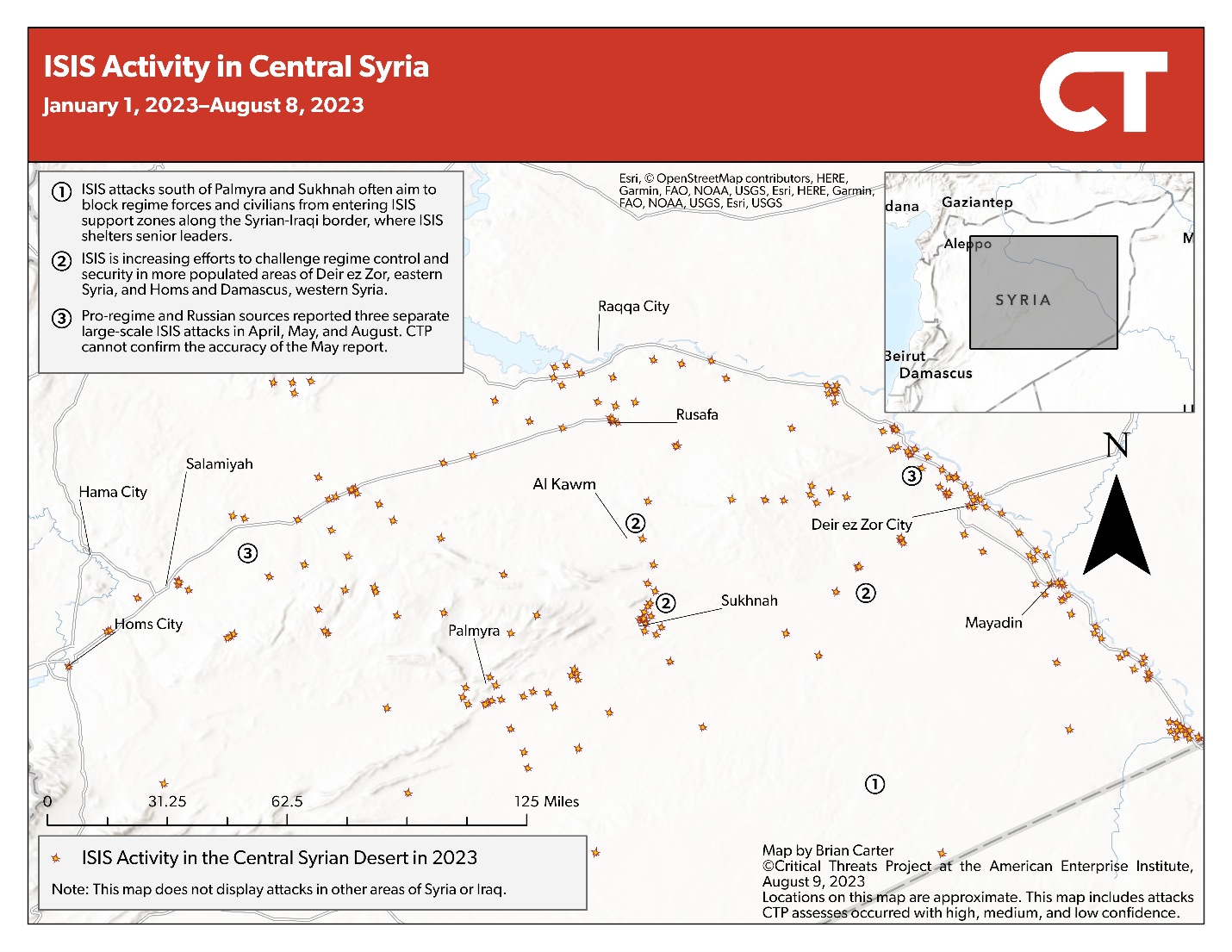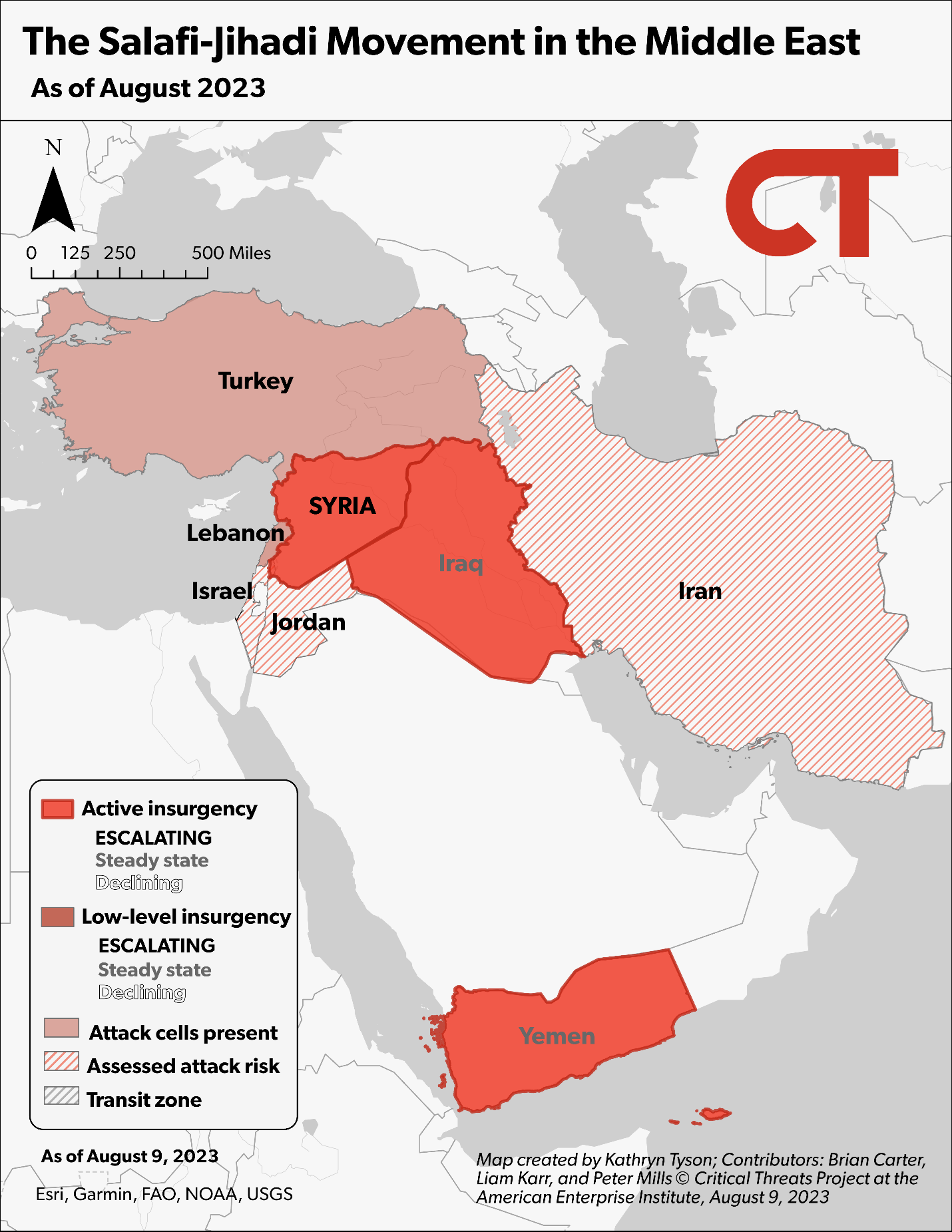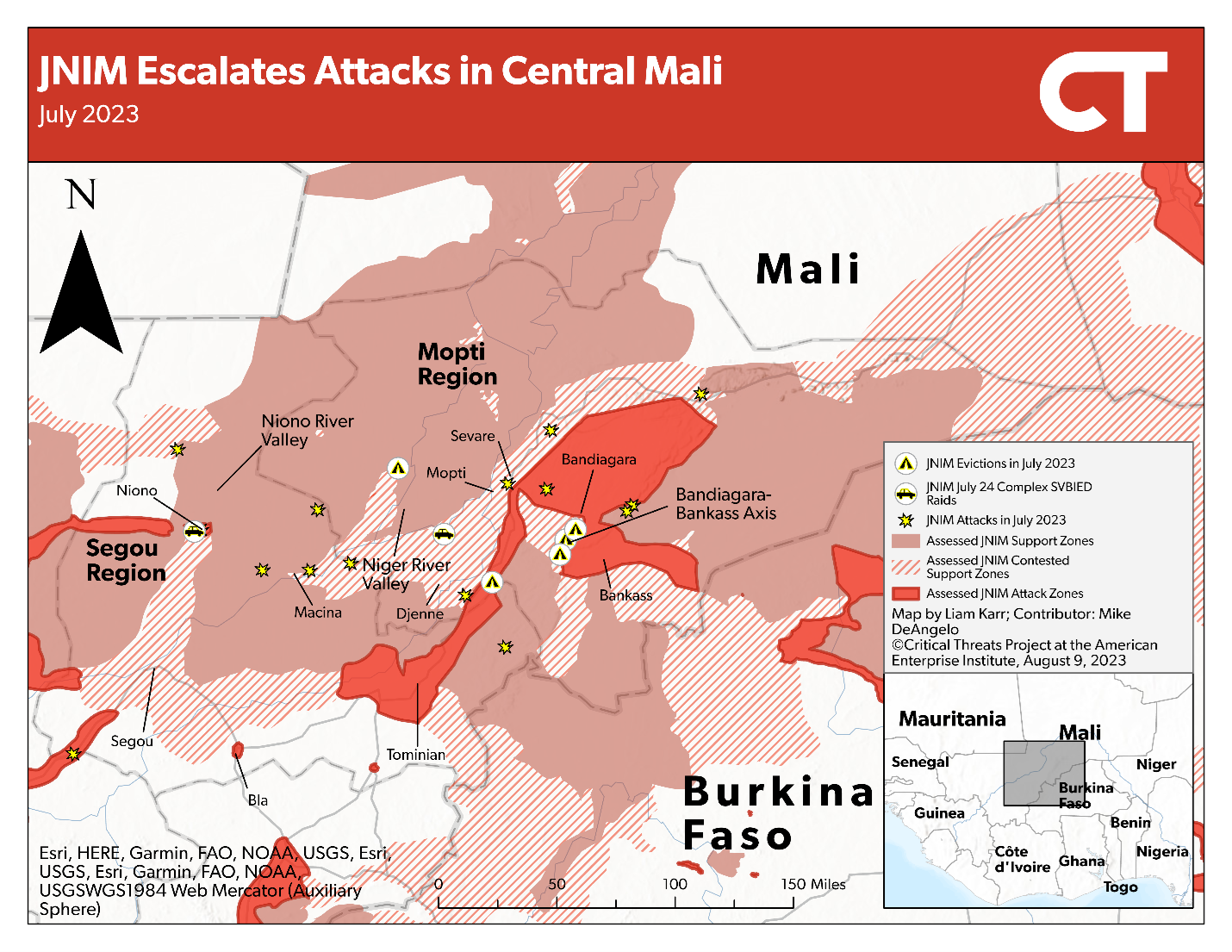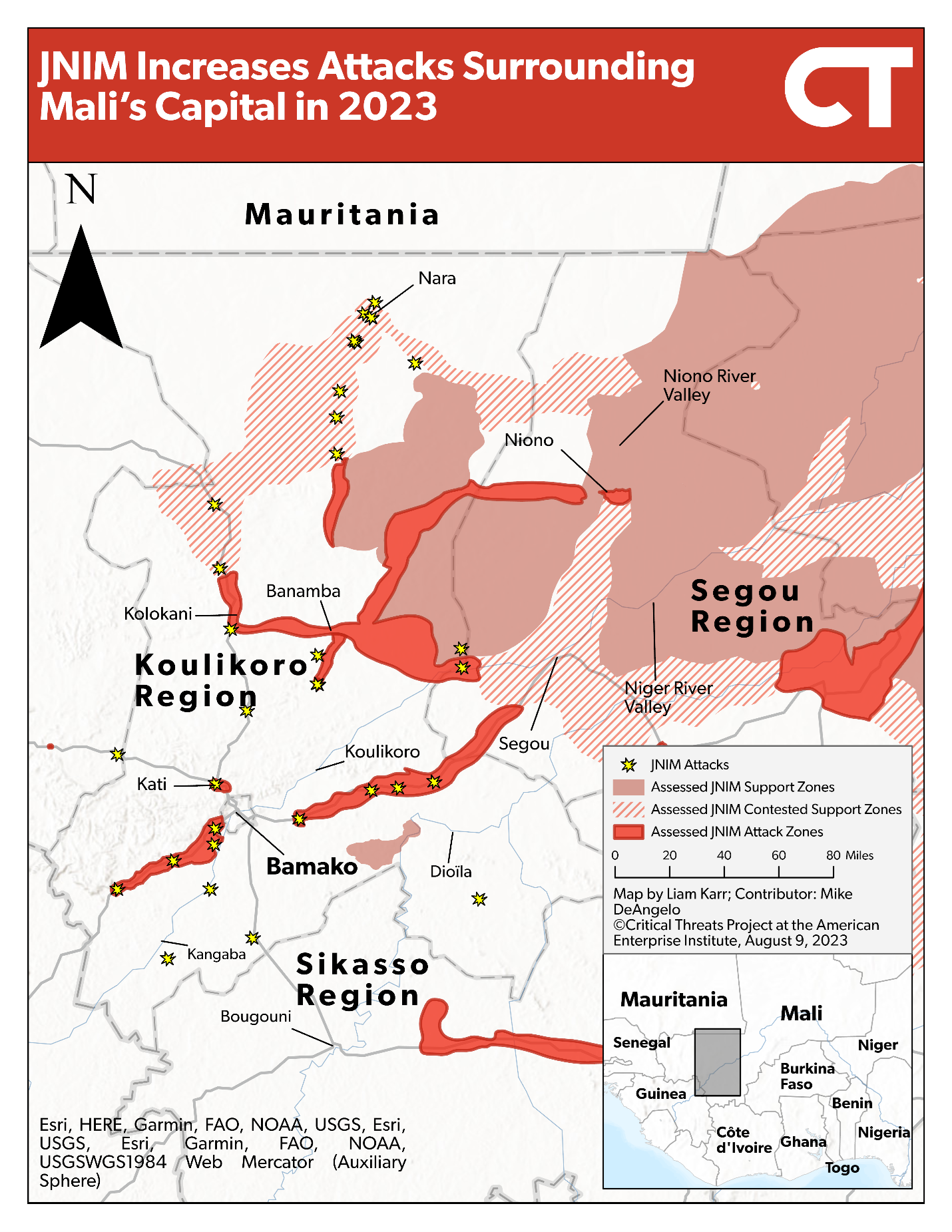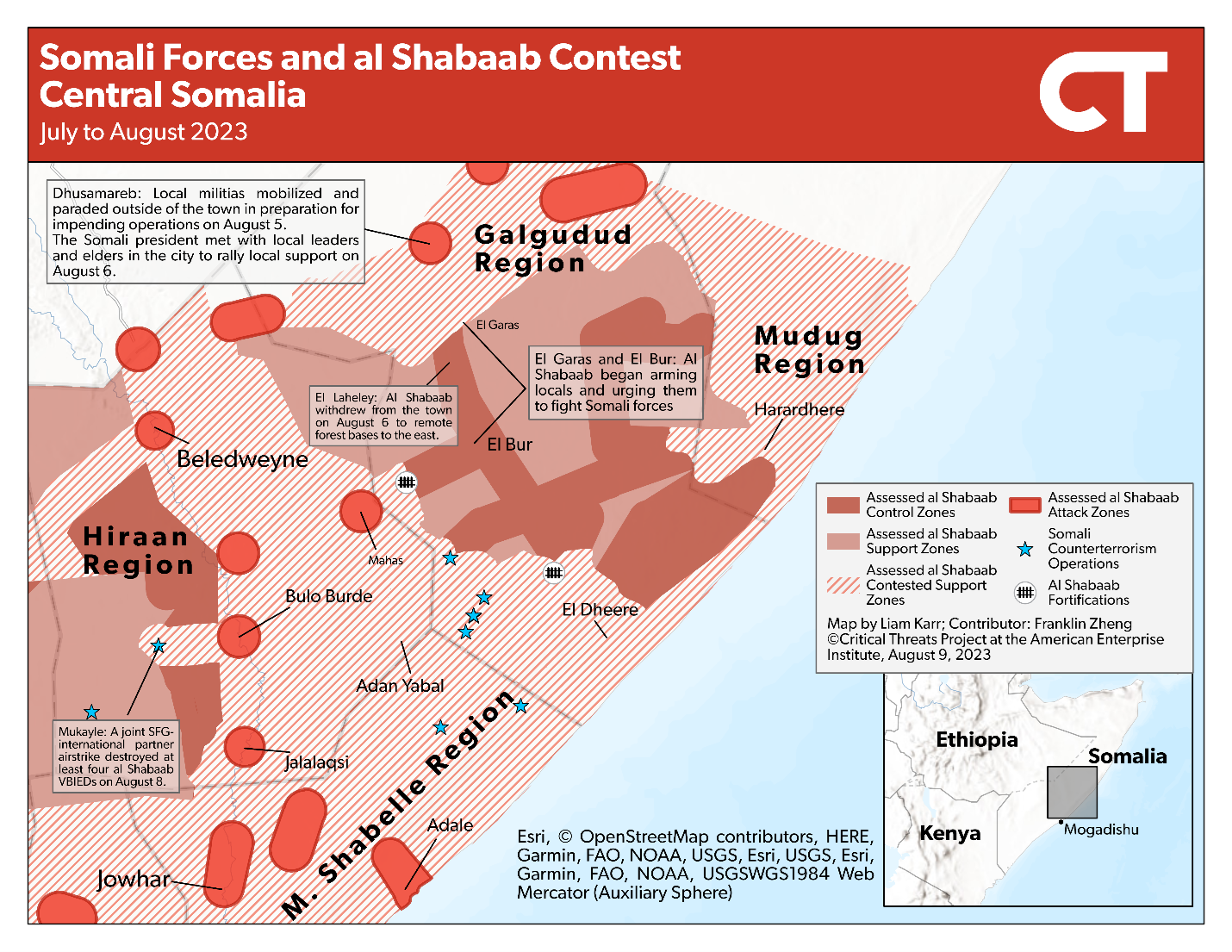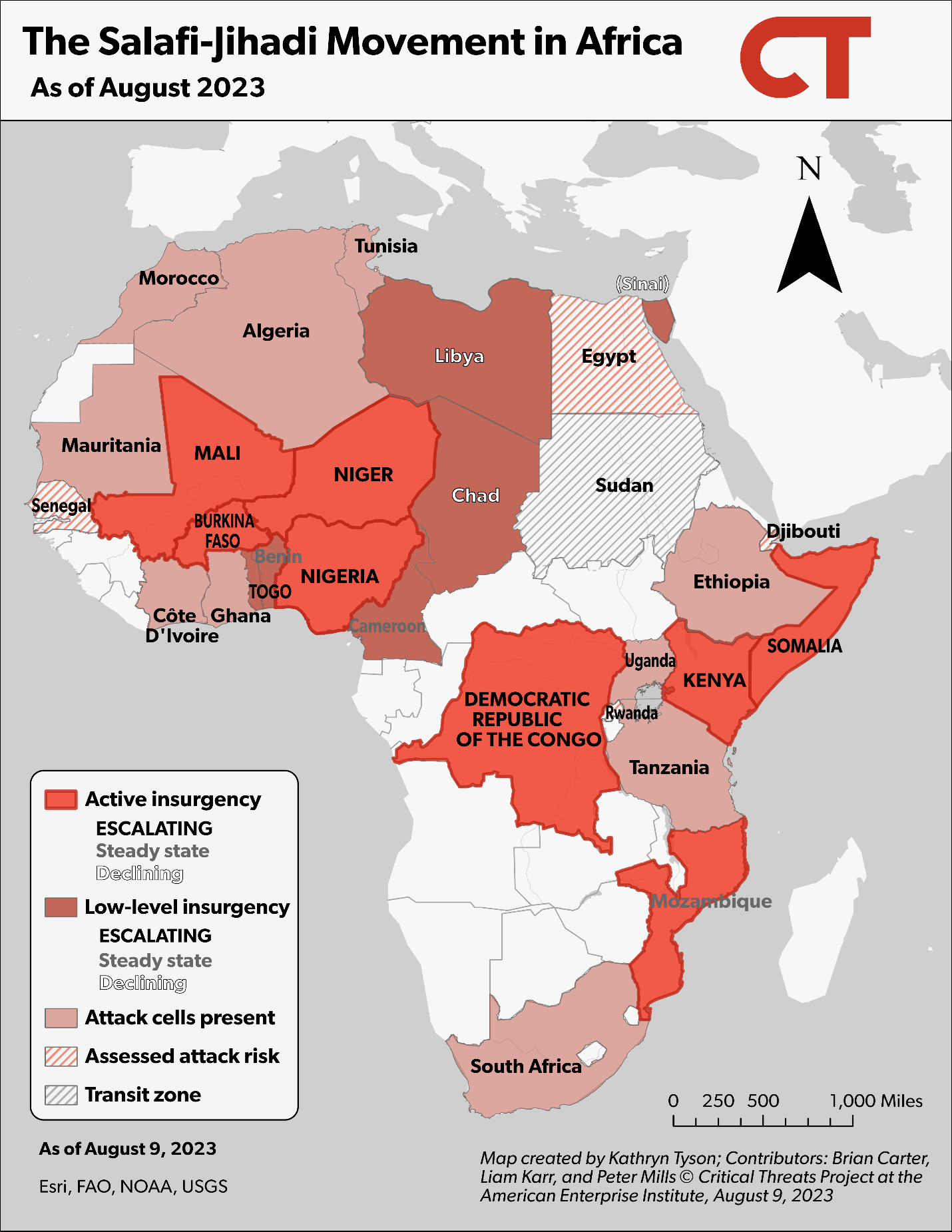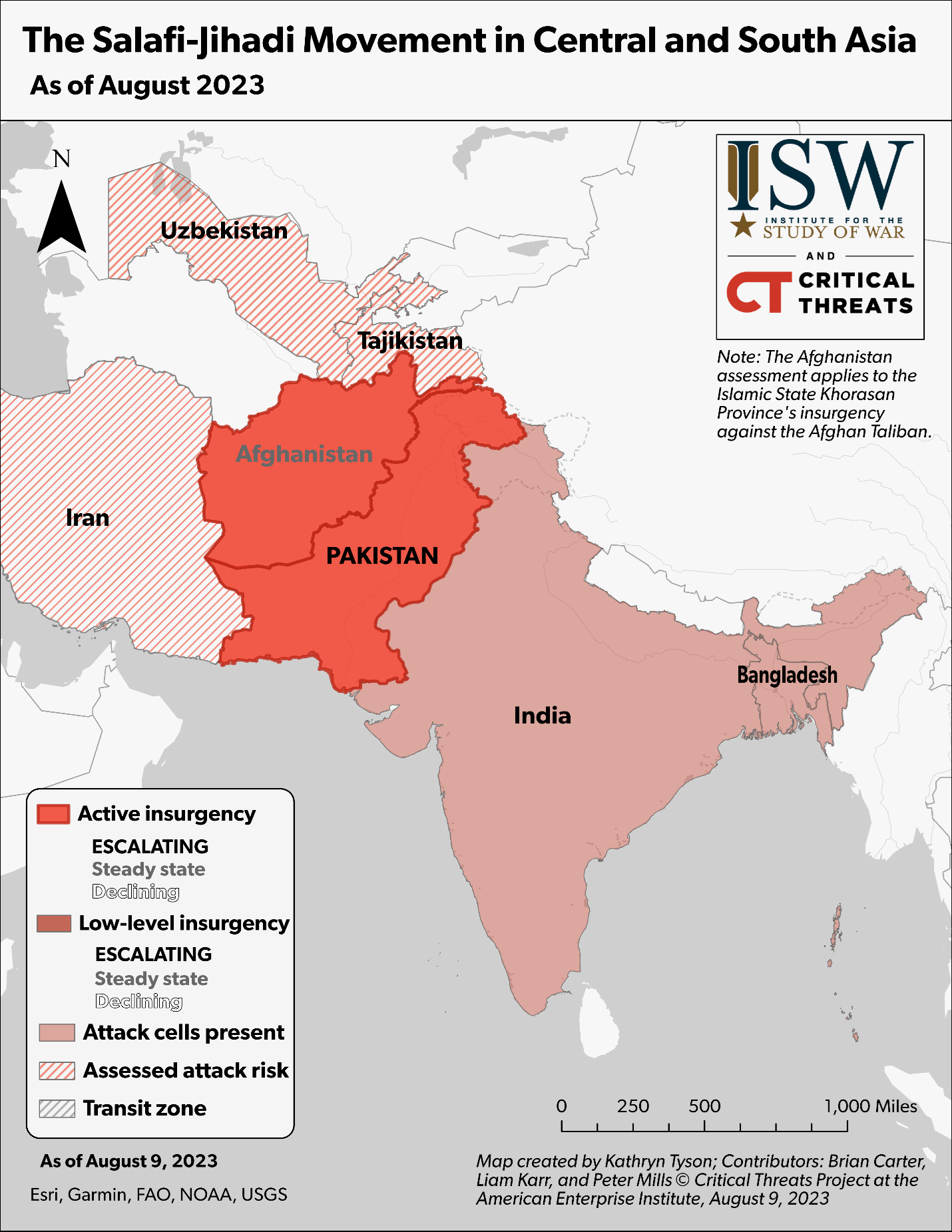 |
 |
Salafi-Jihadi Movement Weekly Update, August 9, 2023

Salafi-Jihadi Movement Weekly Update, August 9, 2023
Authors: Brian Carter, Kathryn Tyson, Liam Karr, and Peter Mills
Data Cutoff: August 8, 2023, at 10 a.m.
Contributors: Mike DeAngelo and Franklin Zheng
Key Takeaways:
Global Movement. Islamic State (IS) affiliates in Africa, South and Central Asia, and the Middle East are establishing greater operational autonomy, which likely will enable them to continue their operations amid a higher rate of IS leadership losses. IS propaganda may offset the loss in morale caused by consistent leadership losses by providing religious legitimacy and projecting strength to IS fighters and supporters.
Iraq and Syria. ISIS announced the elimination of its “caliph” on August 3, but continued leadership decapitation is unlikely to successfully defeat ISIS in Iraq and Syria. The Syrian regime’s lack of focus on killing and detaining mid-level ISIS leaders will enable the group to execute its campaign plan in Syria, which aims to set conditions for an ISIS resurgence after a US withdrawal.
Niger. The Nigerien junta plans to use the Kremlin-funded Wagner Group and local volunteer militias to bolster security in the capital and may intend to use both against Salafi-jihadi insurgents after securing its hold on power. Relying on these auxiliary forces risks increasing human rights abuses and exacerbating communal tensions, which would create opportunities that Salafi-jihadi groups have historically exploited.
Mali. Al Qaeda–linked militants increased the rate and severity of their attacks in central Mali in July, indicating the group is strengthening in area despite Malian and Wagner Group counterterrorism operations. Al Qaeda associate Jama’at Nusrat al Islam wa al Muslimeen (JNIM) will likely use its growing support zones in central Mali to besiege larger towns in the area into submission and conduct more frequent and more severe attacks in southern Somalia to challenge the junta’s legitimacy.
Somalia. The Somali Federal Government (SFG) will likely resume its offensive to capture the last al Shabaab–controlled district capital in north-central Somalia in the coming weeks. Al Shabaab will likely avoid conventional defensive engagements for complex suicide vehicle-borne improvised explosive device (SVBIED) counterattacks as it did during the initial phase of the offensive.
Afghanistan. The Taliban government is delegitimizing Taliban participation in attacks beyond Afghanistan, possibly in response to recent diplomatic engagement with the United States and pressure from Pakistan. The Taliban is unlikely to prevent Afghan Taliban members from supporting Tehrik-e Taliban Pakistan operations in Pakistan.
Assessments:
Global Movement.
Author: Kathryn Tyson
Figure 1. Tenure of Islamic State “Caliphs” from 2013 to 2023
Source: Kathryn Tyson.
IS affiliates in Africa, South and Central Asia, and the Middle East are establishing greater operational autonomy, which likely will enable them to continue their operations amid a higher rate of IS leadership losses. Anti-ISIS actors in Syria have been killing IS leaders more quickly—months after their appointments—since 2019. IS acknowledged the death of IS leader Abu al Husayn al Husayni al Qurashi on August 3, and new IS spokesperson Abu Hudhayfah al Ansari announced Abu Hafs al Hashimi al Qurashi as the new ISIS “caliph.”[1] IS affiliates in Afghanistan, Central Africa, India, Iraq, Pakistan, Somalia, West Africa, and Yemen have so far pledged allegiance to the new leader.[2] IS affiliates are also adapting to losses of core leadership by exercising more operational autonomy.[3] This will enable IS affiliates to plan and execute external attacks without direction from central leadership, should they choose to do so.
- The most recent IS leader led the group for under six months—from November 2022 to April 2023—and had the shortest time in power of any IS leader.[4] This instability illustrates for IS branches the importance of not developing dependencies on the core. See Figure 1 for a timeline of IS leadership and their deaths.
- IS delegated decision-making to a system of administrative offices between 2017 and 2019.[5] These offices support multiple IS branches at a time so that individual groups are less reliant on the IS core. These offices coordinate funding and material support and provide guidance to the various affiliates.
- IS affiliates in Afghanistan, Syria, and West Africa are strengthening to varying degrees. US Central Command assessed in March 2023 that IS-Khorasan Province (ISKP) could attack the United States or its allies within six months.[6] ISKP has also infiltrated the Taliban’s security apparatus and managed to carry out attacks against high-profile targets, despite some setbacks.[7] Conditions in Africa favor Salafi-jihadi expansion, and IS’s affiliates in the Sahel and West Africa have expanded their influence in their respective theaters.[8] The IS province in Syria is slowly rebuilding its own capabilities, particularly in central Syria. (See Iraq and Syria section.)
IS propaganda may offset the loss in morale caused by consistent leadership losses by providing religious legitimacy and projecting strength and cohesion to IS fighters and supporters. The lack of clarity after the IS leader’s April death caused consternation within IS ranks, particularly in Iraq and Syria. IS is attempting to justify its losses by analogizing itself to the early Islamic community, or umma, to strengthen unity within the ranks. This will resonate with IS fighters because IS commonly analogizes its setbacks and successes with the experiences of the early Islamic community. The IS pledge campaign to support the new leadership also aims to provide the leader with legitimacy to the rank and file while demonstrating the group’s continued unity. The importance of propaganda for IS means the capture of IS’s spokesperson in April was a significant loss, because the spokesperson is important to communicating strategic-level guidance to lower-level commanders.[9]
- New IS spokesperson Abu Hudhayfah al Ansari said on August 3 in an audio announcement that “what happened to the four Caliphs [IS’s previous four leaders], may Allah have mercy on them, is what happened to the previous Rightly-Guided Caliphs [the first four caliphs of the Islamic community].”[10] IS has previously analogized its strategic approach with the Islamic Prophet’s approach in early Islamic history for religious legitimacy.[11]
- IS consistently claims its setbacks are tests of followers’ adherence and religious beliefs. IS’s weekly magazine on July 27 assured fighters that the challenges they face are part of a divine plan and instructed them to continue attacks.[12]
- IS members criticized IS leadership in July 2023 due to the lack of clarity on the new leader’s identity.[13] The delays between the death of an IS leader and the announcement of a new leader have increased since early 2022. There were six-week delays after the death of an IS leader in spring 2022 and again in fall 2022.[14] In 2023, IS delayed more than three months before announcing its new leader.[15]
Iraq and Syria.
Author: Brian Carter
Continued leadership losses are unlikely to successfully defeat ISIS in Iraq and Syria.[16] ISIS announced the elimination of its “caliph” on August 3 after Turkey killed the caliph and captured the chief ISIS spokesperson in an April raid.[17] ISIS command and control in Syria is decentralized, especially at the operational level and below, which enables the group to continue its campaigns without interruption despite leadership losses at the strategic level.[18] The United States and the Syrian Democratic Forces (SDF) kill and detain operational-level leadership, which forced ISIS cells in northeastern Syria to decentralize and contains the group to a greater degree than regime forces do in regime-held central Syria.[19] ISIS is strengthening in central Syria, which demonstrates that the “caliph’s” elimination in April did not degrade or prevent ISIS from maintaining its campaigns.[20] That the group is claiming attacks in central Syria indicates it perceives it is strengthening and can repulse regime attacks.
- ISIS began decentralizing its forces after the transition to insurgency in 2017–18 as counterinsurgent pressure ebbed and flowed.[21] ISIS commanders are siloed off from each other in northeastern Syria, where US and partner forces continue to maintain significant pressure on the group.[22]
- The United States and its primary partner force, the SDF, conducted 34 partnered operations and one unilateral US operation killing or detaining ISIS fighters between April and June 2023.[23] These operations usually target tactical and operational commanders.[24] ISIS does not shelter senior commanders in northeastern Syria out of fear of US raids, but it does hide senior commanders in regime-held Syria.[25]
- ISIS perceives it is strengthening despite leadership losses. It is also conducting attacks in new areas and demonstrating new capabilities that it has not had since at least 2020. ISIS claimed responsibility for attacks in the central Syrian desert in June and July 2023. This is a change from the December 2022 to June 2023 period, during which the group claimed no attacks in the area despite the highest levels of ISIS activity in central Syria since the fall of the territorial “caliphate.”[26] The group has claimed seven attacks in central Syria since June and three attacks in Damascus city since May.[27] CTP has previously assessed that attacks in Damascus are supported from the central Syrian desert.[28]
Figure 2. ISIS Activity in Central Syria in 2023
Source: Brian Carter.
The operational-level leadership’s ability to freely operate in some areas of Syria will likely enable ISIS to rebuild its strength in populated areas. ISIS has already begun infiltrating populated areas in regime-held Syria. Accelerating this effort would provide ISIS greater human and physical resources it can exploit to raid or capture key infrastructure, such as prisons and oil infrastructure.[29] ISIS is not physically contained to unpopulated areas in the Syrian desert, where it is operating using large formations staged in areas it controls to target oil infrastructure and regime bases. These large-scale operations occurred after the caliph’s death, indicating that these operations do not require high-level guidance. These large ISIS forces are putting regime forces on the defensive, enabling smaller ISIS cells to raid and penetrate populated areas. Regime forces do not kill or capture operational-level ISIS leadership or clear ISIS support zones in any meaningful way, which enables ISIS to shelter its leaders and plan and conduct operations from its support zones. CTP previously assessed that these support zones also provide the group with areas its cells in northeastern Syria can retreat to when under pressure from the US and SDF operations.
- ISIS maneuvered large formations in a major offensive on at least two occasions since April. Hundreds of ISIS fighters fought Russian private military contractors to a standstill in central Syria during a multi-week campaign ending in mid-April.[30] A Kremlin-affiliated milblogger reported that 150 ISIS fighters attacked Russian positions north of Sukhnah, Homs province, in late May, though CTP cannot independently confirm the veracity of this report.[31] ISIS forces launched the “largest attack in years” on a pro-regime base near Shula, Deir ez Zor, on August 7.[32]
- Syrian regime counter-ISIS operations are usually short-term clearing operations. These operations do not hold territory to prevent ISIS from reentering it and do not regularly remove mid-level ISIS leaders from the battlefield.[33] ISIS consistently ambushes regime forces with improvised explosive devices (IEDs) and small arms to block them from entering its support zones along the Syria-Iraq border in regime-held Syria, where it shelters senior leaders.[34]
- ISIS began targeting more populated areas in western Syria and along the Euphrates River in regime-held Deir ez Zor from support zones in central Syria to challenge regime control and security of the population. ISIS fighters flew flags and own the night in the vicinity of Musarib, north of Deir ez Zor city, according to both opposition and pro-regime sources.[35] The group has resumed attacks in more populated areas of western Syria, conducting three attacks in Damascus city since May.[36] Before May, the last ISIS attack in Damascus was in 2021.[37]
Figure 3. The Salafi-Jihadi Movement in the Middle East
Source: Kathryn Tyson.
Niger.
Author: Liam Karr
The Nigerien junta plans to use the Kremlin-funded Wagner Group and local volunteer militias to bolster security in the capital and may intend to use both against Salafi-jihadi insurgents after securing its hold on power.[38] The junta is most immediately concerned with deterring the West African regional and political bloc—the Economic Community of West African States (ECOWAS)—from invading to reinstate the Nigerien president.[39] The new informal alliance among Sahelian juntas makes the deployment of Wagner to Niger more feasible due to the large Wagner contingent in Mali and the Nigerien junta and Wagner’s explicit mutual interest in a Wagner Group deployment to Niger.[40] In a scenario in which the junta remains in power, the junta will need to replace the loss of Western counterterrorism support, such as by hiring the Wagner Group or strengthening local militias, as CTP previously assessed.[41]
- A Nigerien delegation met with Wagner officials in Mali on August 2 and requested the “rapid deployment” of Wagner forces to Niger.[42] A team of Wagner Group advisers and trainers met with junta officials in Niamey on August 5, and a prominent Wagner-linked milblogger claimed on August 6 that Wagner will send a limited deployment to Niamey to “protect the capital.”[43] There is no indication the junta is currently planning to use either militias or the Wagner Group for counterterrorism purposes.
- The junta has created small volunteer militias in Niamey that patrol roundabouts.[44] These groups only number in the tens according to the Agence France Press, and it is unclear if the groups are armed.[45]
- The Burkinabe, Malian, and Nigerien juntas formed an informal alliance on July 31.[46] This alliance is premised on the juntas’ shared experience with coups, international isolation, and anti-Western policies.[47] A thousand Wagner fighters are in Mali, and the Malian junta said it would militarily support Niger if ECOWAS invaded.[48]
Relying on the Wagner Group or civilian militias risks increasing human rights abuses and exacerbating communal tensions that would likely create opportunities that Salafi-jihadi groups have regularly exploited. Nigerien and other Sahelian forces have been responsible for numerous human rights violations while attempting to contain the Salafi-jihadi threat in the Sahel.[49] However, the introduction of the Wagner Group in Mali and civilian militias in Burkina Faso amplified the already-present human rights violations against civilians.[50] The spread of such abuses in Niger would inflame local grievances and ethnic violence that Salafi-jihadi groups take advantage of, undoing the progress the Nigerien government has made by limiting support for local self-defense groups.[51]
- The Burkinabe junta has emphasized that arming poorly trained and largely ethnically homogenous volunteer militias is part of its counterterrorism strategy.[52] These militias have carried out several massacres related to ethnically motivated violence, pushing alienated communities to cooperate with Salafi-jihadi groups for protection.[53]
- Wagner has increased the amount of violence against civilians in Mali by encouraging Malian forces to use coercive tactics and directly participating in collective punishment massacres.[54] The Malian army killed more civilians in 2022 than all previous years of the Sahel insurgency combined.[55] These abuses support Salafi-jihadi groups’ recruitment by driving vulnerable citizens to partner with the militants for protection.[56]
- The Nigerien government has avoided supporting self-defense militias and emphasized communal reconciliation since it stopped supporting ethnically based Malian militias in 2018.[57] Malian groups operating in Niger had exacerbated instability by exacerbating ethnic violence that drove some civilians to partner with Salafi-jihadi groups in the border region of Mali and Niger instead of stemming the insurgency.[58] Ethnic tensions remain high in this border area of northwestern Niger, and militia formation or Wagner targeting certain ethnic groups will reverse the government’s progress.[59]
Mali.
Author: Liam Karr
Contributor: Mike DeAngelo
Al Qaeda–linked militants increased the rate and severity of their attacks in central Mali during July, indicating the group is strengthening in the area despite Malian and Wagner Group counterterrorism operations. JNIM carried out 22 attacks in central Mali in July, more than twice its monthly average in 2023.[60] Two of these attacks were complex SVBIED raids, one of which overran a Malian army base.[61] JNIM requires nearby support zones to manufacture the vehicle-borne improvised explosive devices (VBIEDs) and stage the fighters involved in these attacks, indicating that JNIM still has functioning support zones in the nearby Niono and Niger River Valleys. This supports CTP’s April assessment that an increase in Malian army and Wagner Group activity in these river valleys from December 2022 to March 2023 did not degrade these support zones.[62]
- JNIM conducted its first two complex SVBIED raids since April 22 targeting Kouakourou and Molodo in Mopti and the Segou region on July 24.[63] JNIM also evicted at least five villages in the Mopti region in July and early August, the majority of which were along the Bandiagara-Bankass axis, suggesting that Wagner and the Malian army have not had success in degrading JNIM support zones in this area, in contrast to CTP’s April assessment that Wagner and Mali may have degraded support zones near the Bandiagara-Bankass axis.[64]
Figure 4. JNIM Escalates Attacks in Central Mali
Source: Liam Karr.
JNIM will likely use its growing support zones in central Mali to besiege larger towns in the area into submission. JNIM has historically besieged population centers to force negotiations and secure a favorable agreement with local leaders instead of taking direct military action.[65] Growing support zones and freedom of movement throughout rural central Mali will allow JNIM to cut roadways surrounding urban centers more easily and target bigger towns.
- The group is currently besieging a major town in the Mopti region for the second time since the beginning of 2022 and demanding that Malian army and Wagner Group forces withdraw from the area.[66]
- JNIM has implemented shadow governance in dozens of villages in central Mali by securing favorable agreements through threats of violence or siege since 2017.[67] The deals decrease violence against civilians and allow local activity to resume in exchange for residents agreeing not to cooperate with security forces and sometimes adhering to aspects of shari’a law.[68]
JNIM will likely take advantage of growing support zones in central Mali to conduct more frequent and more severe attacks in southern Mali to challenge the junta’s legitimacy in politically sensitive areas. JNIM’s strengthening support zones will increase its freedom of movement and logistical support from local populations.[69] The group has already used these advantages to support its attack campaign in Mali’s capital region in southern Mali.[70] The 2023 campaign has consisted of smaller-scale raids, IED attacks, and ambushes along major roads in southern Mali, but JNIM has the capability and intent to conduct larger attacks.[71] This offensive primarily seeks to disrupt lines of communication in southern Mali and discredit the Malian junta, and more complex attacks would support this objective by demonstrating the junta cannot contain the insurgency.[72]
- The group has averaged nearly six attacks per month in Mali’s capital region in 2023. This surpasses the total number of attacks it conducted in 2022.[73]
- JNIM has regularly targeted roadways in southern Mali that are adjacent to or connect to its support zones in the Niger and Niono River Valleys in central Mali, which suggests that the group has support zones in these areas to stage attacks.[74]
- JNIM has the capability and intent to conduct major attacks in and around the capital. JNIM launched an SVBIED attack targeting the Malian army’s main base in southern Mali, which is 10 miles from Bamako, in July 2022.[75]
Figure 5. JNIM Increases Attacks Surrounding Mali’s Capital in 2023
Source: Liam Karr.
Somalia.
Author: Liam Karr
Contributor: Franklin Zheng
The SFG will likely begin the next phase of its offensive against al Shabaab in north-central Somalia in the coming weeks. The SFG mobilized significant local support for a renewed offensive in north-central Somalia’s Galgudud region in early August.[76] Local forces are essential to the SFG for resuming operations against al Shabaab and for its ability to hold territory after operations.[77] Somali special forces with international partner air support cleared large gatherings of al Shabaab militants along frontline areas in July to disrupt al Shabaab staging grounds that the group could use to launch preemptive attacks or counterattacks on government staging areas.[78] Al Shabaab has also taken several defensive measures, indicating it expects an imminent offensive.[79]
- The Somali president visited the Galgudud regional capital to rally support from local leaders and elders on August 6.[80] Pictures on social media also show the mass mobilization of militia fighters in Dhusamareb, the Galgudud regional capital, in early August.[81]
- A lack of local support had stalled operations pressuring El Bur—the last al Shabaab–controlled district capital in north-central Somalia—along multiple axes since September 2022.[82]Al Shabaab negotiated deals with the dominant clans in some of these areas, causing local militias to stop working with the SFG.[83] Locals stopped supporting the offensive on other axes after their leaders disagreed with their federal counterparts on drone-strike usage and distrusted government support for their intra-clan rivals in the area.[84]
- Al Shabaab has withdrawn from several frontline villages, erected defensive structures near other frontline areas, and armed civilians in early August.[85] The group withdrew from dozens of villages in south-central Somalia before Somali forces captured them peacefully in fall 2022.[86]Al Shabaab also met with local leaders and elders to shore up its own local support in early August.[87]
Figure 6. Somali Forces and al Shabaab Contest Central Somalia
Source: Liam Karr.
Al Shabaab will likely avoid conventional defensive engagements in favor of complex SVBIED counterattacks. Al Shabaab largely avoided large-scale conventional battles and preemptively withdrew during the initial phase of the SFG’s offensive in 2022.[88] It then launched a series of complex SVBIED raids that inflicted significant casualties and halted the SFG offensive in January 2022.[89] Al Shabaab has already withdrawn from at least one town along the main road to its regional stronghold, indicating it is using these same tactics.[90]
Figure 7. The Salafi-Jihadi Movement in Africa
Source: Kathryn Tyson.
Afghanistan.
Author: Peter Mills
The Taliban government is delegitimizing Taliban participation in attacks beyond Afghanistan, possibly in response to recent diplomatic engagement with the United States and pressure from Pakistan. Taliban Supreme Leader Hibatullah Akhundzada and his defense minister both issued statements forbidding Taliban members from conducting attacks beyond Afghanistan.[91] This a shift from January 2023, when Akhundzada delegitimized the Pakistani state in a statement that supported TTP propaganda.[92] Pakistan has repeatedly criticized the Taliban for failing to crack down on TTP safe havens inside Afghanistan in 2023. Afghan Taliban members reportedly participated in a major TTP-affiliated attack in Pakistan on July 12.[93] The Taliban shared Akhundzada’s decree banning attacks beyond Afghanistan during meetings between senior Taliban leaders and Pakistan’s special representative to Afghanistan from July 19 to July 21, indicating the Taliban is looking for ways to mollify Pakistan.[94] The Taliban also continues to reiterate commitments to prevent terror groups from using Afghan territory to attack the US and its allies as part of ongoing diplomatic engagement with the US.[95]
- Akhundzada issued a decree on an unknown date to Taliban security services that declared attacks beyond Afghanistan forbidden for all Taliban members. The Taliban defense minister gave a speech on August 5 publicly discussing this decree and reiterated that Taliban fighters are forbidden from fighting beyond Afghanistan.
- Pakistan has alternated between rhetorical and military pressure toward the Taliban government. The Pakistani chief of army staff threatened the Taliban with cross-border operations if it did not crack down on TTP safe havens on July 14 and August 7.[96] The Pakistani foreign minister similarly threatened cross-border raids into Afghanistan on August 1.[97] The Pakistani military followed up on these threats by shelling alleged TTP positions in Barmal District, Paktika Province, Afghanistan, on July 25 and flying fighter jets over Kunar Province on August 3.[98] TTP leaders maintain hideouts and safe havens in both locations, indicating these Pakistani operations were backing up threats to target the TTP in Afghanistan to militarily pressure the Taliban to change its policy toward the TTP.[99]
- On July 30–31, the Taliban foreign minister met with the US special representative for Afghanistan in Doha, where they discussed Taliban efforts to fulfill its security commitments.[100]
The Taliban is unlikely to prevent Afghan Taliban members from supporting TTP operations in Pakistan. Both senior Taliban leaders and the Taliban rank and file support the TTP, which makes it politically difficult for the Taliban government to crack down on Taliban support for the TTP.[101] Akhundzada did not publish his decree publicly, suggesting he is concerned about these internal disagreements within the movement. It is also unclear how Akhundzada’s decree would apply to operations in the border regions of Pakistan, since the Taliban does not recognize its border with Pakistan.[102] Taliban restraints on its own members will also not prevent the TTP in eastern Afghanistan from supporting TTP operations in Pakistan, thereby threatening the Pakistani state.
Figure 8. The Salafi-Jihadi Movement in Central and South Asia
Source: Kathryn Tyson.
[1] SITE Intelligence Group, “IS Announces Death of ‘Caliph’ Abu al-Husayn, Appointment of Successor and New Spokesperson,” August 4, 2023, available by subscription at www.siteintelgroup.com.
[2] SITE Intelligence Group, “IS Begins Pledges to New Leader with Photos from Iraq, West Africa, Somalia, and Yemen,” August 7, 2023, available by subscription at www.siteintelgroup.com; https://twitter.com/caleb_weiss7/status/1688949041499975683; https://twitter.com/AfghanAnalyst2/status/1688772405752188928; https://twitter.com/cozyduke_apt29/status/1688616654769631233?s=20; https://twitter.com/khorasandiary/status/1687729010300628992?s=20
[3] https://documents-dds-ny.un.org/doc/UNDOC/GEN/N23/189/74/PDF/N2318974.pdf?OpenElement
[4] https://www.cnn.com/2022/11/30/middleeast/isis-leader-dies-intl/index.html
[5] https://www.un.org/securitycouncil/ctc/sites/www.un.org.securitycouncil.ctc/files/n2243078.pdf; https://www.nytimes.com/2023/02/04/us/politics/isis-somalia-kabul-bombing.html
[6] https://www.voanews.com/a/us-general-islamic-state-afghan-affiliate-closer-to-attacking-western-targets/7008633.html
[7] https://www.criticalthreats.org/analysis/salafi-jihadi-movement-weekly-update-june-7-2023#AFG20230607; https://www.criticalthreats.org/analysis/salafi-jihadi-movement-weekly-update-march-16-2023; https://www.nytimes.com/2023/04/25/us/politics/isis-leader-killed-kabul-airport-bombing.html#:~:text=WASHINGTON%20%E2%80%94%20The%20Taliban%20have%20killed,White%20House%20said%20on%20Tuesday
[8] https://www.aei.org/foreign-and-defense-policy/a-global-terror-threat-rises-in-nigeria; https://www.criticalthreats.org/analysis/salafi-jihadi-movement-weekly-update-may-10-2023; https://www.criticalthreats.org/analysis/salafi-jihadi-movement-update-special-edition-niger-coup-wagner-group-and-an-ecowas-intervention-threaten-to-further-destabilize-the-sahel; https://www.criticalthreats.org/analysis/salafi-jihadi-movement-special-edition-wagner-will-remain-in-africa
[9] https://www.crisisgroup.org/middle-east-north-africa/east-mediterranean-mena/syria/containing-resilient-isis-central-and-north#:~:text=After%20its%20final%20territorial%20defeat,from%20the%20group%27s%20media%20signalling; https://extremism.gwu.edu/sites/g/files/zaxdzs5746/files/The_Long_Jihad.pdf
[10] SITE Intelligence Group, “IS Announces Death of ‘Caliph’ Abu al-Husayn, Appointment of Successor and New Spokesperson,” August 4, 2023, available by subscription at www.siteintelgroup.com.
[11] https://ctc.westpoint.edu/guerrilla-caliph-speeches-bookend-islamic-states-caliphate-era
[12] SITE Intelligence Group, ”Ahead of Ashura Holiday, IS Encourages Perseverance in Affliction and Migration to Provinces,” August 1, 2023, available by subscription at www.siteintelgroup.com.
[13] https://twitter.com/NihadJariri/status/1678327801873670145
[14] https://www.aei.org/foreign-and-defense-policy/is-isis-in-crisis; https://www.cnn.com/2022/11/30/middleeast/isis-leader-dies-intl/index.html
[15] https://www.france24.com/en/live-news/20230430-turkey-s-erdogan-says-isis-commander-has-been-killed-in-syria
[16] https://jihadology.net/wp-content/uploads/_pda/2023/08/The-Islamic-State-al-Naba%CC%84-Newsletter-402.pdf
[17] https://www.aa dot com.tr/en/turkiye/turkiye-neutralizes-daesh-isis-leader-al-qurayshi-in-syria-president/2885556
[18] https://www.crisisgroup.org/middle-east-north-africa/east-mediterranean-mena/syria/containing-resilient-isis-central-and-north
[19] https://twitter.com/alsharqia24news/status/1661021579374125058; https://sdf-press dot com/en/2023/06/our-sdf-capture-arsonist-responsible-for-crop-burning-and-extortion; https://npasyria dot com/en/98286; https://sdf-press dot com/?p=39441; https://twitter.com/CENTCOM/status/1627072236460072973?s=20
[20] https://www.criticalthreats.org/analysis/salafi-jihadi-movement-weekly-update-august-2-2023#IraqSyria20230802; https://www.counterextremism.com/blog/isis-redux-central-syria-insurgency-june-2023
[21] https://www.crisisgroup.org/middle-east-north-africa/east-mediterranean-mena/syria/containing-resilient-isis-central-and-north#:~:text=After%20its%20final%20territorial%20defeat,from%20the%20group's%20media%20signalling
[22] https://media.defense.gov/2023/Aug/04/2003274797/-1/-1/1/LEAD%20INSPECTOR%20GENERAL%20FOR%20OPERATION%20INHERENT%20RESOLVE%20FY23Q3.PDF; https://www.crisisgroup.org/middle-east-north-africa/east-mediterranean-mena/syria/containing-resilient-isis-central-and-north
[23] https://media.defense.gov/2023/Aug/04/2003274797/-1/-1/1/LEAD%20INSPECTOR%20GENERAL%20FOR%20OPERATION%20INHERENT%20RESOLVE%20FY23Q3.PDF
[24] https://twitter.com/alsharqia24news/status/1661021579374125058; https://sdf-press dot com/en/2023/06/our-sdf-capture-arsonist-responsible-for-crop-burning-and-extortion; https://npasyria dot com/en/98286; https://sdf-press dot com/?p=39441; https://twitter.com/CENTCOM/status/1627072236460072973?s=20
[25] https://undocs.org/S/2023/549
[26] https://www.criticalthreats.org/analysis/salafi-jihadi-movement-weekly-update-august-2-2023#IraqSyria20230802
[27] https://www.criticalthreats.org/analysis/salafi-jihadi-movement-weekly-update-august-2-2023#IraqSyria20230802; https://jihadology.net/wp-content/uploads/_pda/2023/08/The-Islamic-State-al-Naba%CC%84-Newsletter-402.pdf
[28] https://www.criticalthreats.org/analysis/salafi-jihadi-movement-weekly-update-august-2-2023#IraqSyria20230802
[29] https://www.counterextremism.com/blog/isis-redux-central-syria-insurgency-june-2023
[30] https://www.mei.edu/publications/isis-beats-back-wagner-offensive-central-syria
[31] https://rybar dot ru/napadenie-na-bazu-vs-rf-v-sirii-tragicheskie-posledstviya-i-mrachnye-perspektivy
[32] https://twitter.com/GregoryPWaters/status/1688809228230914049?s=20
[33] https://www.criticalthreats.org/analysis/ending-the-us-presence-in-syria-could-cause-a-rapid-isis-reconstitution-and-threaten-core-us-national-security-interests; https://www.counterextremism.com/content/unsolved-murders-syrias-badia-truffle-hunters-crosshairs-and-isis-large
[34] https://undocs.org/S/2023/549; https://www.criticalthreats.org/analysis/salafi-jihadi-movement-weekly-update-may-17-2023#IraqSyria20230519
[35] https://npasyria dot com/151923; https://twitter.com/thesyrianlions/status/1682147409088970752?s=20
[36] https://www.criticalthreats.org/analysis/salafi-jihadi-movement-weekly-update-august-2-2023#IraqSyria20230802
[37] https://twitter.com/GregoryPWaters/status/1656306204782501888?s=20
[38] https://www.letemps dot ch/monde/afrique/alors-que-la-pression-monte-sur-la-junte-nigerienne-des-brigades-de-veille-gardent-les-ronds-points-de-niamey; https://twitter.com/sentdefender/status/1687854151831572480?s=20; https://twitter.com/casusbellii/status/1687854347848126466?s=20; https://t.me/wargonzo/14218
[39] https://www.letemps dot ch/monde/afrique/alors-que-la-pression-monte-sur-la-junte-nigerienne-des-brigades-de-veille-gardent-les-ronds-points-de-niamey; https://twitter.com/sentdefender/status/1687854151831572480?s=20; https://twitter.com/casusbellii/status/1687854347848126466?s=20; https://t.me/wargonzo/14218
[40] https://www.criticalthreats.org/analysis/salafi-jihadi-movement-update-special-edition-niger-coup-ecowas-invasion-in-limbo; https://twitter.com/sentdefender/status/1687854151831572480?s=20; https://twitter.com/casusbellii/status/1687854347848126466?s=20; https://t.me/wargonzo/14218
[41] https://www.criticalthreats.org/analysis/salafi-jihadi-movement-update-special-edition-niger-coup-wagner-group-and-an-ecowas-intervention-threaten-to-further-destabilize-the-sahel
[42] https://twitter.com/SimNasr/status/1686725855408496640?s=20; https://twitter.com/casusbellii/status/1686639253231398912?s=20; https://twitter.com/criticalthreats/status/1684668764623720448?s=20
[43] https://www.criticalthreats.org/analysis/salafi-jihadi-movement-update-special-edition-niger-coup-ecowas-invasion-in-limbo; https://twitter.com/sentdefender/status/1687854151831572480?s=20; https://twitter.com/casusbellii/status/1687854347848126466?s=20; https://t.me/wargonzo/14218
[44] https://www.letemps dot ch/monde/afrique/alors-que-la-pression-monte-sur-la-junte-nigerienne-des-brigades-de-veille-gardent-les-ronds-points-de-niamey
[45] https://www.letemps dot ch/monde/afrique/alors-que-la-pression-monte-sur-la-junte-nigerienne-des-brigades-de-veille-gardent-les-ronds-points-de-niamey
[46] https://www.france24.com/en/africa/20230801-burkina-faso-and-mali-say-intervention-in-niger-would-be-declaration-of-war
[47] https://www.france24.com/en/africa/20230801-burkina-faso-and-mali-say-intervention-in-niger-would-be-declaration-of-war
[48] https://www.bbc.com/news/world-africa-66051450; https://www.france24.com/en/africa/20230801-burkina-faso-and-mali-say-intervention-in-niger-would-be-declaration-of-war
[49] https://www.hrw.org/news/2021/02/13/sahel-end-abuses-counterterrorism-operations; https://www.amnesty.org/en/documents/afr37/2318/2020/en
[50] https://jamestown.org/program/mass-civilian-defense-force-recruitment-raises-jihadist-threat-to-civilians-in-burkina-faso; https://www.hrw.org/news/2023/06/29/burkina-faso-unlawful-killings-disappearances-army; https://www.criticalthreats.org/briefs/africa-file/africa-file-wagner-group-in-burkina-faso-will-help-the-kremlin-and-hurt-counterterrorism; https://www.hrw.org/news/2022/04/05/mali-massacre-army-foreign-soldiers
[51] https://www.criticalthreats.org/analysis/salafi-jihadi-movement-update-special-edition-niger-coup-wagner-group-and-an-ecowas-intervention-threaten-to-further-destabilize-the-sahel
[52] https://jamestown.org/program/mass-civilian-defense-force-recruitment-raises-jihadist-threat-to-civilians-in-burkina-faso
[53] https://www.criticalthreats.org/analysis/salafi-jihadi-movement-weekly-update-april-27-2023#Sahel20230427
[54] https://www.csis.org/analysis/massacres-executions-and-falsified-graves-wagner-groups-mounting-humanitarian-cost-mali
[55] https://acleddata.com/conflict-watchlist-2023/sahel
[56] https://ctc.westpoint.edu/how-the-wagner-group-is-aggravating-the-jihadi-threat-in-the-sahel
[57] https://www.clingendael.org/publication/self-defence-groups-politics-and-sahelian-state; https://hdcentre.org/news/hd-brokers-peace-agreement-by-communities-from-banibangou-in-nigers-tillabery-region-text-and-video
[58] https://www.crisisgroup.org/africa/sahel/niger/289-sidelining-islamic-state-nigers-tillabery
[59] https://www.crisisgroup.org/africa/sahel/niger/b172-murder-tillabery-calming-nigers-emerging-communal-crisis; https://www.criticalthreats.org/analysis/salafi-jihadi-movement-update-special-edition-niger-coup-wagner-group-and-an-ecowas-intervention-threaten-to-further-destabilize-the-sahel
[60] Author’s research.
[61] SITE Intelligence Group, “JNIM Reports Control over Malian Army Post Following Attack in Mopti, Details 4-Man Suicide Raid on Russian PMC Wagner Group in Segou,” July 27, 2023, available by subscription at www.siteintelgroup.com
[62] https://www.criticalthreats.org/analysis/salafi-jihadi-movement-weekly-update-april-27-2023#Sahel20230427
[63] SITE Intelligence Group, “JNIM Reports Control over Malian Army Post Following Attack in Mopti, Details 4-Man Suicide Raid on Russian PMC Wagner Group in Segou.”
[64] Author’s research; https://www.criticalthreats.org/analysis/salafi-jihadi-movement-weekly-update-april-27-2023#Sahel20230427
[65] https://www.crisisgroup.org/africa/sahel/mali/mali-enabling-dialogue-jihadist-coalition-jnim
[66] https://maliactu dot net/insecurite-au-centre-du-mali-les-passagers-de-plusieurs-compagnies-de-transport-en-detresse-entre-douentza-et-gossi; SITE Intelligence Group, “JNIM Claims 2-Week Siege of Village in Mopti to ‘Pressure’ Malian Army, Russian PMC Wagner Group,” August 7, 2023, available by subscription at www.siteintelgroup.com
[67] https://www.crisisgroup.org/africa/sahel/mali/mali-enabling-dialogue-jihadist-coalition-jnim
[68] https://www.thenewhumanitarian.org/2022/05/04/we-accept-save-our-lives-how-local-dialogues-jihadists-took-root-mali; https://www.icwa.org/mali-insurgents-agreements
[69] https://www.criticalthreats.org/briefs/africa-file/africa-file-Malian-Army-Abuses-Will-Strengthen-Salafi-Jihadis-in-Central-Mali
[70] https://www.criticalthreats.org/analysis/salafi-jihadi-movement-weekly-update-april-27-2023#Sahel20230427
[71] Author’s research; https://www.criticalthreats.org/analysis/salafi-jihadi-movement-weekly-update-april-5-2023#Mali20230405; https://www.voanews.com/a/al-qaida-affiliate-claims-attack-on-mali-s-main-military-base-/6671461.html
[72] https://www.criticalthreats.org/analysis/salafi-jihadi-movement-weekly-update-april-5-2023#Mali20230405
[73] Author’s research; https://africacenter.org/spotlight/mali-catastrophe-accelerating-under-junta-rule; https://www.criticalthreats.org/analysis/salafi-jihadi-movement-weekly-update-january-18-2023; https://www.criticalthreats.org/analysis/salafi-jihadi-movement-weekly-update-april-5-2023#Mali20230405
[74] https://www.criticalthreats.org/analysis/salafi-jihadi-movement-weekly-update-april-27-2023#Sahel20230427
[75] https://www.voanews.com/a/al-qaida-affiliate-claims-attack-on-mali-s-main-military-base-/6671461.html
[76] https://www.radiodalsan dot com/galmudugs-traditional-elders-unite-with-government-to-fight-al-shabaab-liberate-the-nation-somalia; https://twitter.com/HarunMaruf/status/1687829431153287168; https://twitter.com/GaroweOnline/status/1687843277045637120?s=20
[77] https://www.criticalthreats.org/analysis/salafi-jihadi-movement-weekly-update-april-12-2023#Somalia20230412
[78] https://sonna.so/en/somali-national-army-destroys-al-shabaab-militants-network-near-bula-burte-town; https://sonna.so/en/somali-national-army-kills-30-al-shabaab-militants-in-fighting
[79] https://www.criticalthreats.org/briefs/gulf-of-aden-security-review/gulf-of-aden-security-review-august-8-2023
[80] https://www.radiodalsan dot com/galmudugs-traditional-elders-unite-with-government-to-fight-al-shabaab-liberate-the-nation-somalia
[81] https://twitter.com/HarunMaruf/status/1687829431153287168?s=20; https://twitter.com/GaroweOnline/status/1687843277045637120?s=20
[82] https://www.criticalthreats.org/analysis/salafi-jihadi-movement-weekly-update-april-12-2023#Somalia20230412
[83] https://www.garoweonline dot com/en/news/somalia/somalia-detains-elders-over-links-to-al-shabaab; https://www.crisisgroup.org/africa/horn-africa/somalia/b187-sustaining-gains-somalias-offensive-against-al-shabaab
[84] https://www.criticalthreats.org/analysis/salafi-jihadi-movement-weekly-update-april-12-2023#Somalia20230412
[85] https://www.caasimada dot net/al-shabaab-oo-ka-baxay-deegaan-u-dhow-dhuusamareeb; https://www.caasimada dot net/gurmadkii-al-shabaab-oo-u-muuqdo-mid-la-kala-jaray; https://www.caasimada dot net/xog-shabaab-oo-hubeeyey-shacabka-ceelbuur-xabsi-dhigay-odayaal-ka-dalbaday
[86] https://twitter.com/GuledWiliq/status/1579596222150586375?s=20&t=yaBB8NYQi74wfZBRhSrqoA; https://www.crisisgroup.org/africa/horn-africa/somalia/b187-sustaining-gains-somalias-offensive-against-al-shabaab
[87] https://radioalfurqaan dot com/2023/08/beesha-maxamuud-hiraab-oo-beyco-la-gashay-al-shabaab
[88] https://www.criticalthreats.org/analysis/salafi-jihadi-movement-weekly-update-january-18-2023; https://www.crisisgroup.org/africa/horn-africa/somalia/b187-sustaining-gains-somalias-offensive-against-al-shabaab
[89] https://www.criticalthreats.org/analysis/salafi-jihadi-movement-weekly-update-january-25-2023
[90] https://www.caasimada dot net/al-shabaab-oo-ka-baxay-deegaan-u-dhow-dhuusamareeb
[91] https://www.youtube.com/watch?v=NWwHEgIzOxM; https://twitter.com/abdsayedd/status/1687945161299357696; https://www.voanews.com/a/afghan-taliban-chief-deems-cross-border-attacks-on-pakistan-forbidden-/7213760.html
[92] https://twitter.com/abdsayedd/status/1618966856672612358
[93] https://understandingwar.org/backgrounder/salafi-jihadi-movement-weekly-update-july-20-2023
[94] https://www.voanews.com/a/afghan-taliban-chief-deems-cross-border-attacks-on-pakistan-forbidden-/7213760.html; https://twitter.com/QaharBalkhi/status/1681718138684035073; https://twitter.com/OCS_AFG/status/1682035064002183171?s=20
[95] https://twitter.com/AfghanAnalyst2/status/1686279797062647808; https://twitter.com/JJSchroden/status/1686154908926443520
[96] https://www.dw.com/en/pakistan-warns-afghan-taliban-against-harboring-militants/a-66240251; https://8am dot media/asim-munir-we-have-a-strong-will-to-suppress-terrorist-groups-in-afghanistan; https://www dot afintl dot com/202308077329; https://twitter.com/TajudenSoroush/status/1688544906854162434?s=20
[97] https://twitter.com/AnasMallick/status/1686341881058172928
[98] https://twitter.com/abdsayedd/status/1687000609923256320?s=20; https://www dot etilaatroz dot com/ps/21282
[99] https://www.rferl.org/a/pakistan-taliban-comanders-killings-talks/31980664.html; https://ctc.westpoint.edu/the-revival-of-the-pakistani-taliban
[100] https://twitter.com/QaharBalkhi/status/1686011687382482944; https://www.state.gov/meeting-of-u-s-officials-with-taliban-representatives
[101] https://www.usip.org/publications/2022/05/pakistans-twin-taliban-problem; https://extremism.gwu.edu/tehrik-e-taliban-pakistan-posture
[102] https://www.usip.org/publications/2022/01/afghanistan-pakistan-border-dispute-heats; https://www.usip.org/events/between-ttp-and-durand-line
